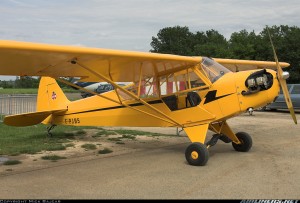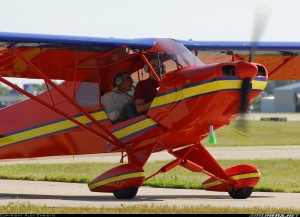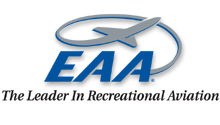 After lots of going back and forth between designs I settled on one. Well at least for now. I ordered a set of plans from Wag-Aero for their Sport Trainer. For the most part when I fly I am either alone or with one other person. So building a four person plane for the once or twice a year I will have that many passengers seems like a waste. I can always stick with my flying club and borrow a Cessna when I need that capability. So my goal with homebuilding is to make something fun to fly that I can’t readily buy as is from from somewhere else. Also if you look at the used J-3 market they are incredibly over priced for what they are. I love the nostalgia as much as the next guy but a canvas plane from 1943 just isn’t worth $50k in my book. Another great plus of this design is that it can easily be built within the Light Sport Aircraft 1,320lb limitation.
After lots of going back and forth between designs I settled on one. Well at least for now. I ordered a set of plans from Wag-Aero for their Sport Trainer. For the most part when I fly I am either alone or with one other person. So building a four person plane for the once or twice a year I will have that many passengers seems like a waste. I can always stick with my flying club and borrow a Cessna when I need that capability. So my goal with homebuilding is to make something fun to fly that I can’t readily buy as is from from somewhere else. Also if you look at the used J-3 market they are incredibly over priced for what they are. I love the nostalgia as much as the next guy but a canvas plane from 1943 just isn’t worth $50k in my book. Another great plus of this design is that it can easily be built within the Light Sport Aircraft 1,320lb limitation.
The Sport Trainer is a Piper J-3 Cub replica with a few improvements. Originally named the CUBy it was designed by Dick Wagner in 1975. The most notable improvement is the fuel tank relocation to the wings. The original Cubs had one fuel tank mounted near the firewall. This created a weight and balance that required solo flight to be done from the rear seat. With the relocation of the tanks to the wings the W&B is changed to allow solo from the front seat. The airfoil used on the Sport Trainer is a USA-35B whereas the J-3 was a ‘modified USA-35B’ and the plans are written for wood ribs and wood spar construction. The J-3 controlled elevator trim with a jack screw. The Sport Trainer uses a trim tab for elevator trim.
There are two more modifications available to this design that Wag-Aero sells as supplements. One being what they call an Acro Sport option the other a Super Sport option. The Acro Sport option is essentially a Reed clipped wing conversion. This is basically a shorter wing and strut mod. It increases the sportiness of the plane rather dramatically. You pay a penalty of course in your glide ratio and take off/landing roll. There is a great article written by Bud Davisson about clipped cubs here. The Super Sport option is a fuselage modification to allow engines with up to 150hp. This involves adding a few tubes to the front of the plane. One draw back to this option is two tubes come right down the front windshield in the field of view. The plus is that with 150hp in this plane you essentially have a mini Super Cub.
The plans available from Wag-Aero are what some might call old school. There are no separate instructions included. You get the set of plans and a full size rib template, that is it. It is up to you to interpret them and figure it out. Of course you can always call the company if you have questions. Another great option is to join the Wag Builders Users Group on Yahoo. There is simply a ton of information on that message board and many people more than happy to help a fellow builder.
I ordered my plans with the Super and Acro sport supplements. They took about a week and a half to arrive. As of now I am leaning to the Acro Sport Trainer but I change my mind on that one every week or so. The cool thing is no matter what I choose the ribs are the same, the only thing that changes is the number of them. You can even change you mind and build the Wag-Aero Wagabond. The ribs are the same for the Sport Trainer and the Wagabond.
Now if I only had the space and money to build an airplane…



